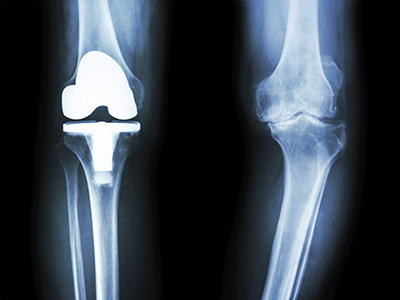
Time and mileage can take their toll on your weight-bearing joints, even more so if you've had prior injury or surgery on your knee. Most of the time with medications, braces, and exercise, you can remain highly functional for years after arthritis begins to get your attention.
However, at some point, if your knee is severely damaged by arthritis or injury, it may be hard for you to perform simple activities, such as walking or climbing stairs. You may even begin to feel pain while you are sitting or lying down. If nonsurgical treatments are no longer helpful, you may want to consider total knee replacement surgery.
Joint replacement surgery is a safe and effective procedure to relieve pain, correct leg deformity, and help you resume some of your activities.
A total knee replacement is a surgical procedure whereby the diseased knee joint is replaced with artificial material.
The knee is a hinge joint, which provides motion at the point where the thigh meets the lower leg. The thighbone (or femur) abuts the large bone of the lower leg (tibia) at the knee joint.
During a total knee replacement, precise cuts are made to the end of the femur bone and the removed bone is replaced with a metal cap. The end of the lower leg bone (tibia) is also removed and replaced with a contoured plastic insert inserted into a tray with a metal stem. Depending on the condition of the kneecap portion of the knee joint, a plastic "button" may also be added under the kneecap surface.
Over 90% of folks with a replacement report dramatic improvement in their symptoms and up to 90% of all prostheses are still functioning well at 15 years.
To schedule your consultation with a top orthopedic surgeon in Webster, TX, please call ☎ (281) 481-2649 or fill out the form below!
David G. Vanderweide, MD
333 N Texas Ave, Suite 2000
Webster, TX 77598
Phone:
(281) 481-2649